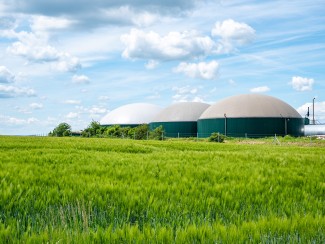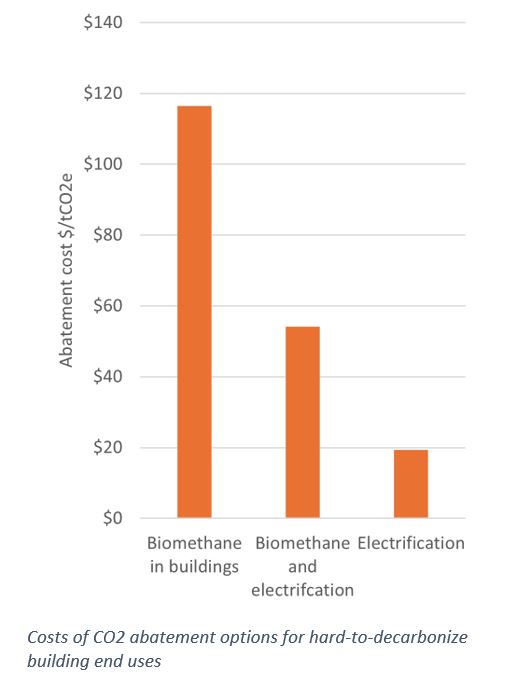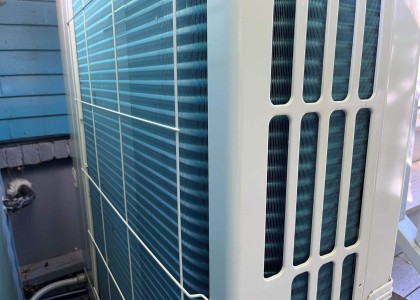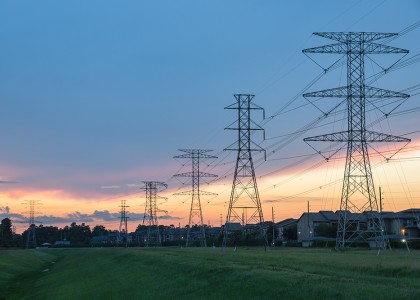New research from the American Council for an Energy-Efficient Economy (ACEEE) finds that relying on alternative fuels is an impractical method for building decarbonization—even in the hardest-to-decarbonize cases—because alternative fuels are more expensive than electricity from renewable sources and because the limited supplies of these fuels will be needed in other priority sectors, such as aviation and peak power generation.
Read the Report ACEEE’s study analyzed costs and emissions for decarbonizing buildings through electrification and alternative fuels for combustion, like biomethane from landfills or livestock manure or synthetic gases made from hydrogen and other chemical compounds. The study looked at “hard-to-decarbonize” building energy uses—which include backup home heating in cold climates, central water heating in large multifamily buildings, and heating commercial buildings in cold climates—and concluded that the 8% of building energy usage for these needs can be most cost-effectively decarbonized through efficient electric heating. For the remaining 92% of building fossil fuel usage, previous ACEEE research has shown that electric heat pumps are the most cost-effective decarbonization method.
The analysis found that shifting to alternative fuels like biomethane—which the gas industry sometimes calls “renewable natural gas”—would cost about six times more than using efficient electric heat pumps in hard-to-decarbonize buildings. Additionally, the fuels are likely to be available in limited quantities: under the most optimistic supply projections, by 2040 alternative fuels could replace only 12% of total fossil fuel use across all energy sectors (e.g., industry, transportation, electricity generation, and buildings).
The cost of using alternative fuels in the hardest-to-decarbonize buildings is approximately $116 per ton of avoided climate pollution, more than six times the cost of using electricity to heat those buildings, which is $19 per ton of avoided climate pollution, the report found. Using a mix of both methods costs less than alternative fuels alone but is still far more expensive than electrification, as shown in the chart below.
“Given the high cost and limited supply of alternative fuels, we need to prioritize their use where they can have the greatest impact, and that’s not in buildings, which are most effectively decarbonized using electric equipment powered by renewable sources,” said Elizabeth Traynor, lead author of the report and building decarbonization analyst at ACEEE. “We need to optimize the use of alternative fuels across sectors, and they are best for uses where we currently have no alternative to fossil fuels, such as much of aviation, maritime shipping, and heavy industry.”
In addition to aviation, maritime operations, and industry, the report found that alternative fuels would likely be needed to meet some peak power demands as electricity generation increasingly moves to renewable sources. The need for dispatchable power generation is currently met with fossil fuel “peaker plants.” Alternative fuels, particularly hydrogen, could provide backup electricity generation with lower emissions than fossil fuels, meaning building electrification and the use of alternative fuels are not necessarily in conflict in a holistic building decarbonization strategy. The report also concluded that although alternative fuels should not be prioritized in buildings, if large-scale, low-emissions, and low-cost biomethane supply is realized in a particular region, it could play a role in decarbonizing some challenging building energy uses.
The study calculated costs and emissions from converting hard-to-decarbonize buildings from fossil fuels to biomethane, synthetic fuels, and full electrification. ACEEE analyzed different scenarios in detail, including peak space-heating in cold climates, domestic hot water supply in multifamily buildings, and meeting peak electricity demand. The study evaluated the effects of integrating alternative fuels into gas distribution systems and isolated centralized uses (such as electricity generation) in assessing whether and how building end-uses should be prioritized among other sectors.




